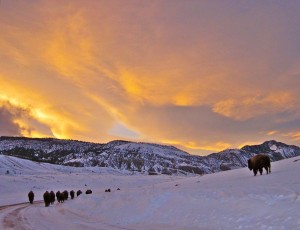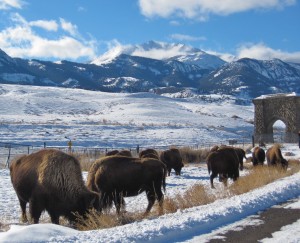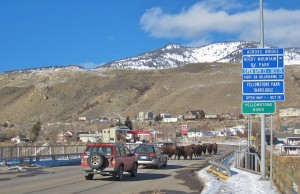
The sun is setting on a band of Yellowstone bison migrating north on the Old Yellowstone Road approaching the park boundary at Reese Creek. Photo: Randy Ingersoll
The never-ending saga and the plight of Yellowstone bison continue to rage with prejudice and bigotry. Two years ago, as agencies prepared to send 500 Yellowstone bison to slaughter—adding to the 3,800 they had already killed since 2000—I wrote a piece entitled “Bison and Bigotry” that highlighted the injustice, hatred and intolerance that drive the mismanagement and slaughter of Yellowstone’s most iconic species. Some things never change.
As bison advocates, we’ve always known that brucellosis—the justification for the slaughter—is no more than a smokescreen for Montana’s fanatical intolerance of bison migrating outside of the park. With new scientific studies indicating that elk, not bison, play the predominant role in transmitting brucellosis—a European cattle disease—to domestic cattle, it would be logical to expect that bison, now exonerated, would have won greater tolerance in their quest to follow their ancestral and biological need to migrate beyond the park’s boundaries. But instead of affording bison the same rights conceded to all other ungulates throughout the ecosystem, the current anti-wildlife Montana legislature has mounted a vehement barrage of attacks.
Thus far, five anti-bison bills have been introduced in the Fish and Game committee, some of which would mandate the slaughter of any bison the minute they step across the arbitrary boundary line of the park. MFWP chief Quentin Kujala was quoted as saying, “There’s a whole bunch of things in the mix, but elk are deep in the hearts of a lot of people. Elk are closer to us than bison are,” in defense of the agency’s plans to continue mismanaging bison as somehow less worthy than elk and other wildlife throughout the ecosystem. After a decade+ of reporting that cited brucellosis as the reason for the slaughter of Yellowstone bison, it’s a breath of fresh air to finally read the truth in articles such as the one that appeared Sunday on the front page of the Bozeman Daily Chronicle, but the reality of what continues to drive the push for slaughter is even more unacceptable than the myth formerly used to justify it.
In light of a Montana legislature hell-bent on introducing bill after bill that are bad for wildlife and toxic for bison, coupled with the departure of Montana Governor Brian Schweitzer, who became a champion of bison in his final term, and recommendations by Park Service officials to cull the herd, the excitement felt by many upon witnessing bison roam the landscape outside of Yellowstone’s North Entrance in the Gardiner Basin during the winter of 2011 feels like a distant memory.
Despite most biologists’ contention that the current population of Yellowstone’s bison has outgrown the capacity of winter range available in the park, the answer lies in allowing bison to utilize the thousands of acres of public land beyond the park’s boundaries and managing them more like elk—not additional slaughter campaigns. What we don’t need are more outlandish legislative attacks aimed at excluding bison from their traditional habitat. At a time when fiscal responsibility is at the forefront of our political debate, how can Montana legislators justify barring Yellowstone bison from the river corridor north of the park that, since 1997, we, the taxpayers, have already paid $16 million to the Church Universal and Triumphant (including an exorbitant $3.3 million deal presumably for grazing rights) to ensure additional winter range for bison?
When we let bigotry and intolerance drive policy instead of science and logic, we all pay the price. The wild places that fill our souls become stained by the blood, fear and hate that steal the hope and inspiration that make places like Yellowstone holy. I will never forget the unfettered joy I experienced during the winter of 2011, driving north, en route to Livingston, when I witnessed stoic and shaggy bison migrating across the landscape. After a decade of watching bison leaving the park march to their deaths, I cherished each sighting, often pulling over along Highway 89 to simply observe that which I knew in my heart was right. More often than not, other passers-by joined me. I always wondered if they knew the significance of what they were witnessing.
With the recent attacks on wolves, the rising deaths of grizzlies, studies targeting elk and continued oppression of bison, Yellowstone’s heartbeat is under attack. For over 140 years, Yellowstone has endured. In recent decades its wildness has been restored, but now is not a time to sit idly on the sidelines hoping for the best.
As Yellowstone’s congregation, we are its guardians. And now, as much as ever, we must harness the audacity from within to passionately speak on its behalf.
In the end, love endures. When you experience the raw power of Yellowstone, your soul awakens to the true essence of love. Yellowstone is a love worth fighting for.
~Michael Leach



EXCEPTIONAL!
The photos made the essay. Thank you for always providing such top notch images for my blogs, articles and presentations Randy. While you will always be known as the enigmatic park pianist who electrifies and inspires visitors to the magnificent Map Room at the Mammoth Hotel, with your passionate stories and lyrical music, your images and love for Yellowstone will be an equally powerful part of your Yellowstone legacy. I’m proud and honored to call you my friend. Much love, Rev